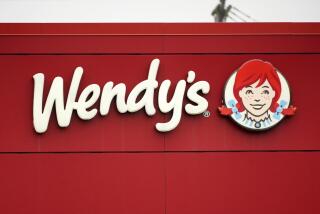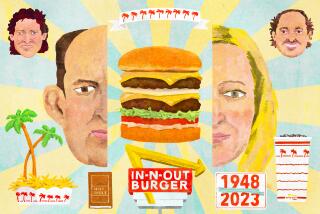Reluctant Star of Wendy’s TV Ads: Its Founder
- Share via
NEW YORK — R. David Thomas, the hamburger restaurant chain founder starring in the new Wendy’s commercials, has no interest in elbowing Chrysler’s Lee A. Iacocca aside as one of America’s best known executive pitchmen.
The beefy high school dropout who amassed a fortune peddling fast food said he’d just as soon retreat to corporate obscurity if Wendy’s ad makers could devise an alternative campaign that would sell hamburgers.
But for now, Thomas is trying to project grandfatherly sincerity and folksy charm in a series of ads designed to reignite growth at the company he named after one of his daughters 20 years ago this fall.
Owns 6% of Stock
“If it works, it’s fine,” Thomas, 57, said as he discussed his new role in an interview. “If it don’t work, I’m gone. . . . I’m history. When I get up in the morning, I’d rather see our stock go up than me on TV.”
He owns about 8% of Wendy’s stock, worth about $40 million at recent market prices.
The ad campaign comes at a potentially pivotal time for Wendy’s International Inc., a Dublin, Ohio-based concern that has lost ground by some measures over the past few years among the nation’s fast-food chains.
Average sales at Wendy’s 3,762 restaurants rose 2.4% to $759,000 per store last year, breaking a three-year slide. But sales per store were well below the company’s peak of $871,000 in 1984, when Clara Peller’s commercial battle cry “Where’s the Beef?” helped stir consumer appetites for Wendy’s.
In those days, Wendy’s ranked third among the fast-food chains behind McDonald’s Corp. and Burger King Corp., which continue to claim the top two spots. But Hardee’s Food Systems Inc. reported average sales of $920,000 at its 3,200 restaurants in 1988, moving ahead of Wendy’s by that measure.
Industry analysts say part of the reason for the decline is that Wendy’s advertising message became muddled after 1984.
An ad called “Russian Fashion Show,” designed to emphasize the choices Wendy’s customers enjoy, generated laughs and awards, but sales per store fell in 1985. Campaigns over the next two years using the themes “Choose Fresh. Choose Wendy’s” and “This is the Good Stuff” failed to halt the decline.
Stress the Basics
In 1988, Wendy’s and its new ad agency, Backer Spielvogel Bates Inc., scored some points with its funny “Hamburger A-Hamburger B” ads in which a pitchman asked strange people to choose between a fresh hamburger from Wendy’s or an obviously inferior product from someone else.
The weirdos always picked Brand X.
But that approach was a reprise of ads another agency had made for Wendy’s years earlier. Backer senior copywriter Jim McKennan looked for something new.
Thomas saw a few suggested approaches, didn’t like them and decided to urge the ad makers to stress the basics of what made Wendy’s different--fresh meat, choice of toppings and custom preparation. “I didn’t think they knew what they were really dealing with,” he said.
After hearing Thomas out, McKennan said Backer’s creative director, Bob Lenz, suggested that they try to talk Thomas into being in the ads himself.
Thomas had appeared in Wendy’s ads in 1981, but his short introductions to the commercials were overshadowed by the controversy that arose over use of a double negative in the same ads: “Ain’t no reason to go anyplace else.”
Wendy’s executives persuaded Thomas, who had stepped back from company operations in 1982 by becoming senior chairman, to return to the front lines.
McKennan viewed it as a rare opportunity. Thomas founded the first Wendy’s in Columbus, Ohio, in 1969 and named it after his daughter Melinda, who was then 8 years old and known to her brother and sisters as “Wenda.”
Putting Thomas in ads would give the company a personality, McKennan felt.
“The theme is that Wendy’s is in his image--American ideals and hard work and giving people a lot for their money. What better way to say that than have the guy who started the whole thing deliver it,” McKennan said.
On the days they shoot ads, McKennan said he and Thomas go over what the ad makers would like him to say, and Thomas decides how he would say it.
‘More Believable’
In one ad, a curly-haired teen-ager sits beside Thomas at a Wendy’s, and Thomas says, “Howdy, dude.”
That was Thomas’ idea, the founder grinned. “In the script, he called me dude. But I told them to let me call him dude, seeing that he looked like one with that earring and all,” he said.
Thomas’ performances in a half-dozen ads to date are unpolished. McKennan said that makes them more believable.
But there are limits to realism. Thomas tools around in a 1952 Studebaker in another ad, but it wasn’t his. Thomas said he didn’t even like the car.
His homespun appeal evidently isn’t universal. Bob Garfield, an ad critic for the trade journal Advertising Age, called Thomas “a steer in a half-sleeve shirt” and said the ads wouldn’t help sales. But Wendy’s executives say sales have improved in the past two months.
More to Read
Inside the business of entertainment
The Wide Shot brings you news, analysis and insights on everything from streaming wars to production — and what it all means for the future.
You may occasionally receive promotional content from the Los Angeles Times.










